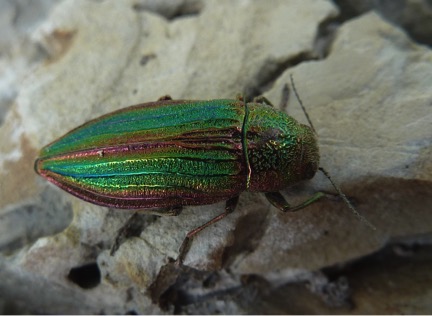
Insect Lives - Buprestid Beetles
Block title

This golden buprestid beetle, Buprestis aurulenta, basked in the summer sun in a rocky draw scattered with Ponderosa pine. Buprestid beetles go by the common names “jewel beetles” or “metallic wood-boring beetles.”
Buprestid bodies assume a long torpedo shape, capped by a wide prothorax and short head. The prothorax bears the beetle’s first pair of legs. In the case of this buprestid, looks a bit like a turtleneck sweater pulled up around its head. This large prothorax provides armor for beetles that spend much of their time unprotected on dying trees and other sunny exposed surfaces.
Most beetles raise their elytra – protective wing covers – during flight, but this slows them down. Buprestids keep their elytra down for fast flight, but this generates a loud buzz when they fly. Their speedy, noisy flight earned them another common name, the buzz beetle.
Adults feed mainly on foliage and lay their eggs on tree bark. Larvae bore into the roots and trunks of trees, where they transition to adulthood in 1-3 years. However, larvae can wait for years, even decades, until conditions for development are right.
Look and listen for these beetles on your next summer foray into Montana’s forests.
References
Arnett, R. H. (1985). American insects: A handbook of the insects of America north of Mexico. New York: Van Nostrand Reinhold.
Marshall, S. A. (2006) Insects: Their Natural History and Diversity : with a Photographic Guide to Insects of Eastern North America. Buffalo, N.Y.: Firefly Books.



















